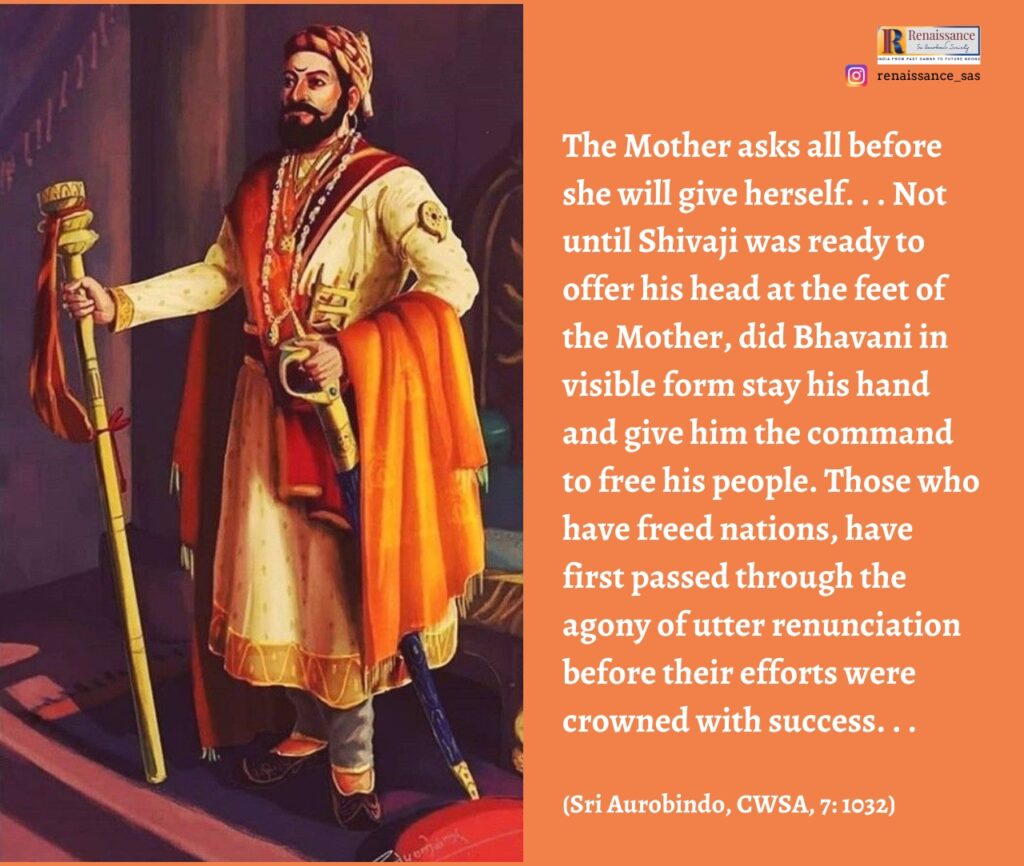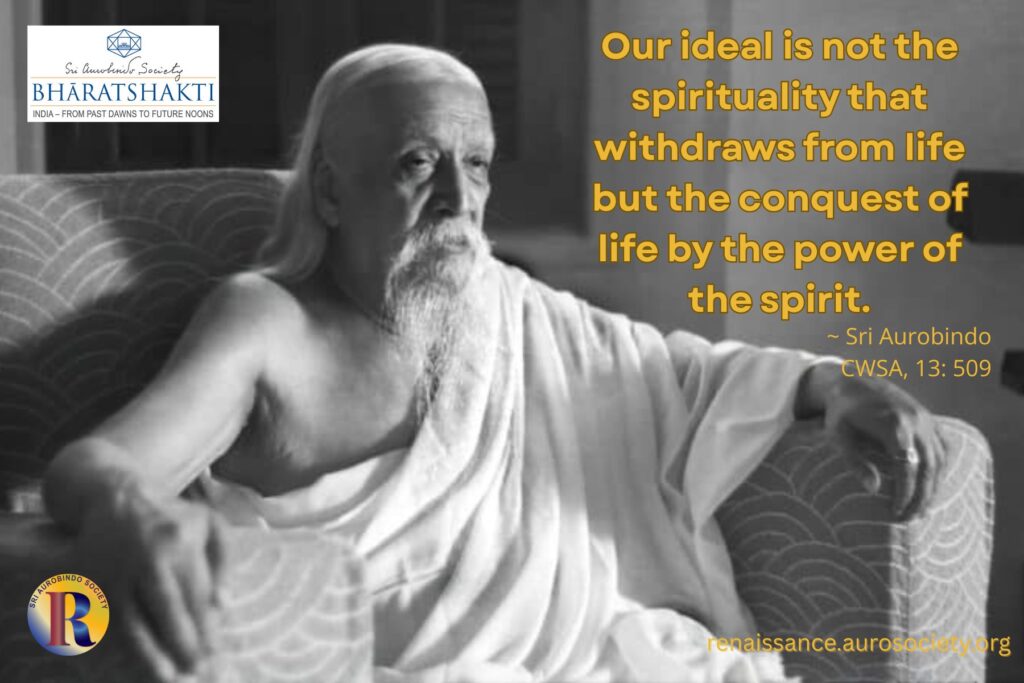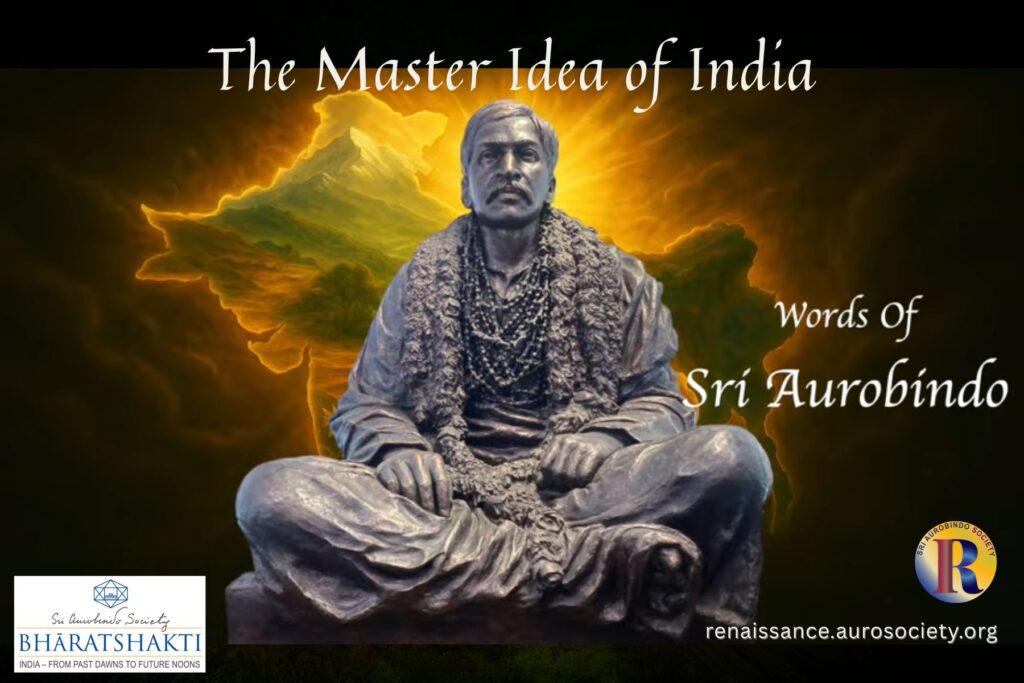Editor’s note: This essay by A. B. Purani is included in his book titled – Sri Aurobindo: Some Aspects of His Vision published by Bharatiya Vidya Bhavan (July 1966, pp. 30-50). It summarises all that was eternal in Sri Aurobindo’s work in the area of India’s cultural renaissance. And it addresses a fundamental question — why did Sri Aurobindo with his cosmic vision of human history wrote at length about Indian culture highlighting the values that are indispensable to the conception of a perfect human culture.
We have made a few formatting revisions and reference corrections for the purpose of this presentation, done in four parts.

Intellect not always able to give correct guidance
When I think of the subject my mind goes back to the nineties of the last century and the first decade of our century. The urge for political freedom was becoming irresistible. In my memory I still see my old uncle scolding my elder brother, the late Sri C. B. Purani, for holding nationalist views as against the philosophy of moderatism. His arguments were logically sound.
The incident and the subsequent trend of events that followed brings home to us a great truth that the intellect is not always able to give correct guidance, especially in moments of individual or national crisis. Something else, some other power in man alone can give the Light.
The stalwarts like Sir P. M. Mehta, the lion of Bombay, G. K. Gokhale of the Servants of India Society, the disciple of M. G. Ranade, and others, men who certainly were patriots, were moderates. Their logic was indubitable, their premises were not mistaken.
Only their conclusion was wrong, their method effete and foredoomed to failure. India, they argued, had never been a nation politically. It is a subcontinent of many groups, speaking two dozen languages, unorganised, enslaved, disunited, poor.
A disarmed people without a living national consciousness could only slowly march to the temple of freedom, particularly, when it has to challenge an empire over which the sun never sets. So, their method was “prayer, petition and protest.” (Sri Aurobindo, CWSA, Vol. 6, p. 287)
[. . .]
It was a time when the Mother called.
It was not a time for logic. There are times in the history of nations when the logic of material facts has to be laid aside. And Sri Aurobindo in those days did concede to the moderate argument and wrote: “Yes, externally we are nothing “; but he argued, “spiritually we are everything.”
It was a time when there was a call, a call to everyone in the nation. It was a time when the Mother called. And thank God, there were her children who disregarding all logic of facts responded to her call and ran to her rescue taking, as we say, their life in their hands.
The feeling has been vividly preserved in the now famous letter to Mrinalini Devi by Sri Aurobindo, fortunately brought to light unintentionally by the Police in the Vande Mataram trial. He wrote:
. . . whereas others regard the country as an inert piece of matter and know it as the plains, the fields, the forests, the mountains and the rivers, I know my country as the Mother, I worship her and adore her accordingly. What would a son do when a demon, sitting on his mother’s breast, prepares to drink her blood? Would he sit down content to take his meals or go on enjoying himself in the company of his wife and children, or would he rather run to the rescue of his mother?
I know I have the strength to uplift this fallen race; not a physical strength, I am not going to fight with a sword or a gun, but with the power of knowledge. The force of the kṣatriya is not the only force, there is also the force of the Brahmin which is founded on knowledge.
(CWSA, Vol. 9, Letter to Mrinalini)
This was the logic of the soul of India which the small number of the nationalists, like Sri Aurobindo, followed.
After the nine nationalist leaders were deported from East Bengal the Jhalakati Conference was held in 1909. A photo of Ashwini Kumar Dutt, the deported leader, was placed in the presidential chair. And Sri Aurobindo, the only leader who happened to be out being acquitted in the Alipur bomb case, declared from the platform:
. . . great as he is, Aswini Kumar Dutta is not the leader of this movement, that Tilak is not the leader,—God is the leader.
~ CWSA, Vol. 8, p. 38
He assured the audience that God is within us all, and an immortal Power works in all. This faith was common to all the nationalist leaders. They strengthened people’s faith in the ultimate victory and taught the nation self-reliance, self-sacrifice and organisation.
Their patriotism had the fervour of religion. The farewell message which Sri Aurobindo gave to the students of the First National College in India in 1906 remains true, even today, for the whole student world of India. He said,
Work that she [India] may prosper. Suffer that she may rejoice.
~ CWSA, Vol. 7, p. 657

“No mere political uprising”
But it was no narrow patriotism or collective ambition. Even in those days of political subjection he declared the aim of the political struggle.
It was “to save the light, to save the spirit of India from lasting obscurantism and debasement,” Sri Aurobindo said that God was raising the nation. He further reminded the audience that there is something that “must come from you which is to save the whole world.” (CWSA, Vol. 7, pp. 818-832)
That “something” was further made clear in the following words:
That something is what the ancient Rishis knew and revealed, and that is to be known and revealed again today, it has to be revealed to the whole world, and in order that He may reveal Himself, you must first realise Him in yourselves, you must shape your lives, you must shape the life of this great nation so that it may be fit to reveal Him and then your task will be done, and you will realise that what you are doing today is no mere political uprising, no mere political change, but that you have been called upon to do God’s work.
~ CWSA, vol. 7, p. 832
It was the time when the national consciousness lying dormant for centuries suddenly awoke. And its dawn automatically emphasised the fundamental elements of India’s culture, a spiritual attitude towards life, a dynamic faith in the guiding Divine Spirit.
Awakening of the National Consciousness
Culture which is a collective creation is not like a house built of bricks. It is a mould of collective consciousness that organises life round values which it evolves during the course of its history.
Culture is, more truly, a living organism that must change according to changing conditions. When a culture becomes rigid, i.e. unable to change, it becomes what Tagore calls achalayatana, inert, a dead mass.
Like all organisms, a culture lives, grows, matures, decay and dies.
But there is a difference which endows culture with a power of longevity. It is the power of revival. A culture that is vitally weak goes down and is either destroyed or changed beyond recognition by the impact of a more powerful culture.
India came in contact with European culture and was dominated by it during the period of her decline. But the very impact of European ideas and literature, its political and social ideals, set into movement a powerful and many-sided revival of Indian culture.
The most important elements of the revival were: (1) the awakening of the religious spirit in new and vigorous forms; (2) the challenge to the political domination of England. Of course, there were literary and other revivals also.
In those early years the only support on which the political movement could count was that of the spirit, a faith in the spirit of Indian culture, a living faith in India’s destiny.
The need for political freedom was not merely for securing material well-being. The chief aim was to have freedom for the expression of the nation’s soul.
Just as the individual has a soul so the collectivity or nation has a soul. Nearly thirty years after the movement Sri Aurobindo wrote:
Each nation is a Shakti or power of the evolving spirit in humanity and lives by the principle which it embodies. India is the Bharata Shakti, the living energy of a great spiritual conception, and fidelity to it is the very principle of her existence.
~ CWSA, Vol. 20, p. 57
It was the feeling and living out this great spiritual truth, the feeling of a living spirit of India, Bharata Shakti, that enabled the small band of Nationalist leaders to fire the imagination of the masses, in fact, to transmit the flame from their hearts to the people and capture the political organisation from the Moderates.
Later on the same movement broadened out by emphasising, through the great personality of Mahatma Gandhi, some salient ethical elements of our spiritual culture. Applying them to political and social problems led India to freedom. And it gave a new ethical weapon to the world for the solution of international problems.

Culture, Harmony and History
What is culture? We have partly answered the question. But a further consideration is needed to make clear the foundations of a culture. There are two sides to a culture; one, political, social and external, including religious institutions, other institutions consisting of basic inner factors, the spiritual elements of a living culture. The external forms must go on changing and adapting themselves to changing historical conditions.
The inner elements remain the same. It is the persistence of these inner elements that gives permanency and maintains the individuality of a culture and makes it grow. An example would make the point clear.
Let us consider the forms which the “will to freedom” assumed in the course of Indian History.
In the 17th century, at the time of Shivaji, the movement for freedom started with the cry of Swadharma and Swaraj and the method adopted was guerrilla warfare. After three centuries the same “will to freedom” burst forth with the cry of “Vande Mataram” with a vision of free Mother India. And satyagraha was the method or the technique.
The earlier movement ended in the establishment of the Maratha confederacy falling short of a united India. And now the latest movement has given us a republic and a united India. Though paradoxically, it has also brought the division of India along religious lines.

Sri Aurobindo enumerates the essential elements of a culture:
The culture of a people may be roughly described as the expression of a consciousness of life which formulates itself in three aspects. There is a side of thought, of ideal, of upward will and the soul’s aspiration; there is a side of creative self-expression and appreciative aesthesis, intelligence and imagination; and there is a side of practical and outward formulation.
~ CWSA, Vol. 20, p. 106
The content of History may be said to be man’s “search for harmony.” Culture is a “harmony of spirit, mind and body” (CWSA, Vol. 20, p. 56).
Some form of harmony was attained by certain cultures in the past. We shall consider only three: (1) The Greek, (2) The Modern European, (3) The Ancient Indian.
The Greek culture was the harmony of disinterested intellectual curiosity, flexible aesthetic temperament, a sense of form, a strong and beautiful body. The modern European culture is the harmony of practical reason, scientific efficiency, and economic capacity of man. It takes these powers as the whole truth of the human being. The Greek mind was “philosophical, aesthetic, political,” the modern mind is “scientific, economic, utilitarian.”
The ancient Indian culture arrived at the harmony of “the spiritual mind working on the other powers of man and exceeding them, the intuitive reason, the philosophical harmony of the Dharma informed by the religious spirit, the sense of the eternal and the infinite.” (CWSA, Vol. 20, p. 235)
During the struggle for independence in India very few leaders saw beyond the political horizon. But there were some who saw that freedom was only a means and not an end, that a new India should emerge as a natural sequel. They saw that new India would have to meet the challenge of European culture with its vital drive, its scientific discoveries and economy-centric outlook.
Why Sri Aurobindo wrote at length about Indian culture?
Indian culture is vast and complex. It has been constantly building new forms adopting them, adapting old forms, changing some and even destroying some. At one time it completely gave the outer forms of Buddhism which it had created.
There is an all-round meeting, mixing and clash of values in the world today based on difference of cultures. And if Indian culture is not merely to survive but make its contribution to humanity today it must rebuild the life of new India on her own spiritual foundation adapted to the needs of the scientific age.
This is the reason why Sri Aurobindo with his cosmic vision of human history writes at length about Indian culture which contains some values that are indispensable to the conception of a perfect human culture.
CONTINUED IN PART 2
~ Design: Beloo Mehra



